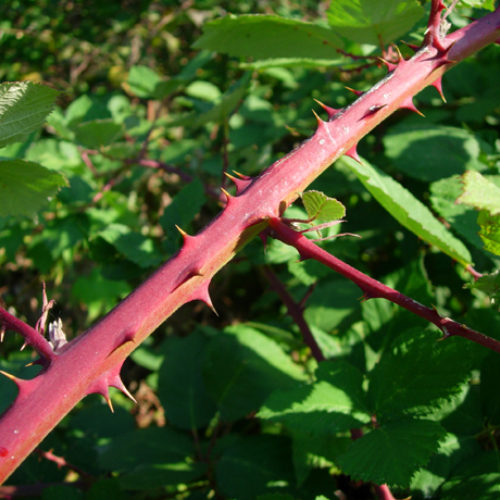Himalayan Blackberry
Rubus armeniacus

Family: Rosaceae
Other Scientific Names:
Rubus discolor, Rubus procerus, Rubus bifrons
Other Common Names: Himalaya blackberry
Weed class: C
Year Listed: 2009
Native to: Asia
Is this Weed Toxic?:
not known to be
Why Is It a Noxious Weed?
It is a notorious invasive species in many countries around the world and costs millions of dollars for both control and in estimated impacts. This species spreads aggressively and has severe negative impacts to native plants, wildlife and livestock.
How would I identify it?
General Description
It is a rambling evergreen, perennial, woody shrub with stout stems that possess stiff, hooked prickles. It may grow up to 13.1 feet. Plants grow into impenetrable thickets.
Flower Description
Flower clusters (panicles) are flat-topped and have 5 to 20 flowers. Each flower has 5 petals that are white to rose colored and about 1 inch in diameter.
Leaf description
Leaves are alternately arranged on stems. Each leaf is palmately compound and made up of 3 to 5 (typically 5) leaflets with toothed margins
Stem description
Stems, commonly called canes, can reach up to 20 to 40 feet and can root at their tips when they touch the ground. Canes have hooked, sharp prickles, also called thorns, with thick bases. Stems green to reddish to purplish-red, strongly angled, and woody. They made dense thickets that are impassable and sprawl over the surrounding vegetation.
Fruit Seed Description
Flowers form blackberries—a grouping of small, shiny, black druplets that each contain one seed. Blackberries are about 1/2 inch to 7/8 inch in size.
Where does it grow?
It can grow in mixed and deciduous forests and a variety of disturbed sites such as roadsides, railroad tracks, logged lands, field margins and riparian areas. It does well in a wide range of soil pH and textures. Please click here to see a county level distribution map of Himalayan blackberry in Washington.
How Does it Reproduce?
It can reproduce by seeds and also vegetatively. Flowers can produce seeds with and without fertilization. It can vegetatively reproduce by re-sprouting rootstalks, rooting stem tips and root and stem fragments.
How Do I Control It?
Make sure to wear thick gloves and protective clothing when controlling blackberry to try to avoid, or at least minimize, injury from the thorns.
Manual/Mechanical Control
For a few plants or small infestations, plant stems can be cut back, leaving about a foot of stem (to not lose track of the plant), and then carefully pull back cut stems with a rake or other tool to allow room for digging up the roots. Example. Then, using a shovel or a tool with a long handle like a mattock or 3-prong tiller mattock, dig out the roots, making sure to remove the main root ball and as much of the spreading side roots as possible. Example of small root mass here. Roots that break off and remain in the soil may resprout, so make sure to monitor the area and control for resprouts and seedlings. Remove from site and dispose of stems and roots.
Cultural Control
Plants can be burned back to the ground, after obtaining any needed permission and permits, and then follow up with other control methods such herbicide on the resprouts as fire will not kill the roots.
Biological Control
Success has been noted from grazing, especially by goats, yet sheep, cattle and horses may also be effective. This method seems to control the population from spreading and becoming larger but does not eradicate the plants from the site.
Herbicide Control
There are a number of herbicide treatment options for Himalayan blackberry. Please refer to the PNW Weed Management Handbook, or contact your county noxious weed coordinator.
For More Information
See our Written Findings for more information about Himalayan blackberry (Rubus armeniacus).
Whatcom County NWCB Fact Sheet on Himalayan Blackberry
Mason County NWCB Fact Sheet on Himalayan Blackberry
Cowlitz County NWCB Fact Sheet on invasive blackberries
Jefferson County NWCB Fact Sheet on invasive blackberries
Whatcom County NWCB Fact Sheet on invasive blackberries
Asotin County NWCB Fact Sheet on invasive blackberries
Clark County NWCB Fact Sheet on invasive blackberries
King County NWCB Fact Sheet on invasive blackberries
Control Options for Blackberry from King County NWCB



















